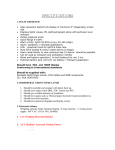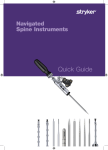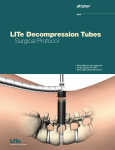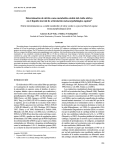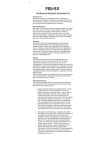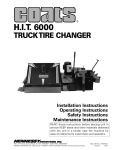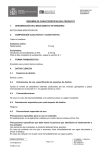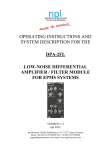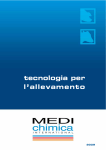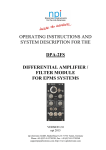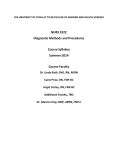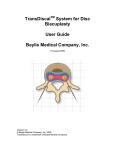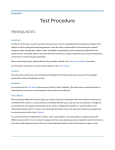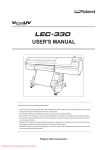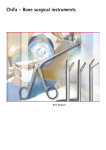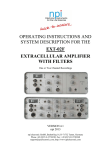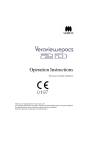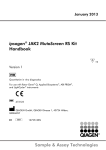Download Luxor™ - Rontis
Transcript
Spine Luxor ™ Surgical Technique • Minimally invasive procedures • Luminated expandable oval retractor • Complete visualization and optimal working space ™ LITe Less Invasive Technologies Luxor ™ Surgical Technique Table of Contents Introduction . . . . . . . . . . . . . . . . . . . . . . . . . . . . . . . . . . . . . . . . . . . . . . . . . . . . . . . . . . . .4 Key Design Features . . . . . . . . . . . . . . . . . . . . . . . . . . . . . . . . . . . . . . . . . . . . . . . . . . . . . .5 Patient Positioning . . . . . . . . . . . . . . . . . . . . . . . . . . . . . . . . . . . . . . . . . . . . . . . . . . . . . . .6 Arm Assembly Positioning . . . . . . . . . . . . . . . . . . . . . . . . . . . . . . . . . . . . . . . . . . . . . . . .6 Lighting Preparation . . . . . . . . . . . . . . . . . . . . . . . . . . . . . . . . . . . . . . . . . . . . . . . . . . . . .7 Establishing Access . . . . . . . . . . . . . . . . . . . . . . . . . . . . . . . . . . . . . . . . . . . . . . . . . . . . . . .8 Markings . . . . . . . . . . . . . . . . . . . . . . . . . . . . . . . . . . . . . . . . . . . . . . . . . . . . . . . . . . . . . . .8 Initial Dilator Insertion . . . . . . . . . . . . . . . . . . . . . . . . . . . . . . . . . . . . . . . . . . . . . . . . . .10 Subsequent Dilator Insertion . . . . . . . . . . . . . . . . . . . . . . . . . . . . . . . . . . . . . . . . . . . . .12 Retractor Assembly . . . . . . . . . . . . . . . . . . . . . . . . . . . . . . . . . . . . . . . . . . . . . . . . . . . . .13 Retractor Insertion . . . . . . . . . . . . . . . . . . . . . . . . . . . . . . . . . . . . . . . . . . . . . . . . . . . . . .15 Retractor Variable Opening/Closing Mechanism . . . . . . . . . . . . . . . . . . . . . . . . . . . . .16 Disc Preparation and Removal . . . . . . . . . . . . . . . . . . . . . . . . . . . . . . . . . . . . . . . . . . . .18 Disc Preparation and Removal Continued . . . . . . . . . . . . . . . . . . . . . . . . . . . . . . . . . .20 Interbody Fusion . . . . . . . . . . . . . . . . . . . . . . . . . . . . . . . . . . . . . . . . . . . . . . . . . . . . . . .21 Graft Insertion . . . . . . . . . . . . . . . . . . . . . . . . . . . . . . . . . . . . . . . . . . . . . . . . . . . . . . . . .22 Screw Insertion: Cannulated . . . . . . . . . . . . . . . . . . . . . . . . . . . . . . . . . . . . . . . . . . . . . .23 Screw Insertion: Non-Cannulated . . . . . . . . . . . . . . . . . . . . . . . . . . . . . . . . . . . . . . . . .31 Rod Insertion . . . . . . . . . . . . . . . . . . . . . . . . . . . . . . . . . . . . . . . . . . . . . . . . . . . . . . . . . .33 Blocker Insertion . . . . . . . . . . . . . . . . . . . . . . . . . . . . . . . . . . . . . . . . . . . . . . . . . . . . . . .37 Construct Tightening . . . . . . . . . . . . . . . . . . . . . . . . . . . . . . . . . . . . . . . . . . . . . . . . . . . .40 Closure . . . . . . . . . . . . . . . . . . . . . . . . . . . . . . . . . . . . . . . . . . . . . . . . . . . . . . . . . . . . . . .41 Contralateral Side . . . . . . . . . . . . . . . . . . . . . . . . . . . . . . . . . . . . . . . . . . . . . . . . . . . . . . .41 Catalog . . . . . . . . . . . . . . . . . . . . . . . . . . . . . . . . . . . . . . . . . . . . . . . . . . . . . . . . . . . . . . .42 Removal or Revision Procedures . . . . . . . . . . . . . . . . . . . . . . . . . . . . . . . . . . . . . . . . . .46 Notes . . . . . . . . . . . . . . . . . . . . . . . . . . . . . . . . . . . . . . . . . . . . . . . . . . . . . . . . . . . . . . .47 Luxor ™ Surgical Technique Acknowledgments Stryker® Spine wishes to thank the global Luxor™ Surgeon Panel for their dedication to the development of the Luxor™ System. Introduction The objective of Stryker Spine Less Invasive Technologies (LITe™) is to replicate the clinical results of the corresponding open procedure. What sets the minimally invasive procedures apart from open procedures is that while delivering similar clinical results, these procedures offer reduced intraoperative blood loss*, reduced post operative mobilization times*, and the potential for minimized postoperative consumption of orally administered narcotics*. The Luxor™ Retractor, part of the LITe™ platform, was designed to provide access to the thoracic and lumbar spine from a posterior approach via a small incision. The oval design of Luxor™ reduces the medial/lateral muscle retraction seen in some circular retractors, while providing more working space at the level of the incision. Important This Surgical Technique sets forth detailed, recommended procedures for using the Luxor™ System. It offers guidance that you should heed but, as with any such technical guide, each surgeon must consider the particular needs of each patient and make appropriate adjustments when necessary and as required. Always refer to the package insert, product label and/or instructions before using any Stryker implant or instrument. Note: No acid or alkaline solvents should be used in the cleaning of anodized components. Note: Upon the completion of each surgical procedure, use adequate suction and irrigation to ensure the removal of any existing non-implantable materials. Note: This is intended as a guide only. There are multiple techniques, and as with any surgical procedure, a surgeon should be thoroughly trained before proceeding. 4 *Data on file at Stryker Spine Key Design Features Key Design Features Radiolucent > Complete visualization of anatomical landmarks Silicon sleeve & Anatomical blades > Prevent tissue from entering surgical site Cobb-style initial dilator > Facilitates tissue dissection while incorporating insertion safety Large distal span > Maximum access at surgical site Oval design > Maximizes working & visualization channels while minimizing tissue damage Thin, shadowless lighting component > Continuous panoramic lighting that conforms to surgical site Reliance LITe™ Decompression Instruments > Bayoneted > Non-reflective coating > Thinner shaft profiles > Increased working shaft length Fixation Instruments > Accommodates Cannulated and Non-Cannulated screws > Rod insertion > Blocker insertion > Construct adjustment and final tightening 5 Luxor ™ Surgical Technique Patient Positioning Luxor™ can be used successfully under local, epidural, spinal or general anesthesia. General anesthesia is commonly used since it is the most comfortable for the patient and allows immediate postoperative neurological assessment. > The patient is prepped and draped in the usual sterile manner for posterolateral fusion with pedicle screw fixation. Figure 1 Arm Assembly Positioning The Mediflex Flex Arm Post (48250240) mounts to the hospital bed rail. Check compatibility of the Mediflex Flex Arm Post to the hospital bed prior to surgery. > Mount the Arm Post to the bed rail on the opposite side of the surgeon near the patient’s hip. > Turn the Arm Post locking mechanism clockwise to secure it to the bed. Figure 2 > Once the Arm Post is secure, attach the Snake Arm (48250230) to the Arm Post and lock into place. > The Snake Arm should be positioned to lie across the patient and wrap in front of the surgeon. Note: For additional information, see the Mediflex Flex Arms™ Surgical User’s Manual. Figure 3 6 48250240 Arm Post Patient Prep Instrument Bar 48250230 Snake Arm Figure 4 48250215 Universal Light Cable Lighting Preparation > Determine the type of light source available in the OR. > Choose the corresponding Luxor™ Lightsource Adapter: 48250210 Lighting Component • Stryker / ACMI / Zimmer Lightsource Adapter (233-050-071) • Storz Lightsource Adapter (233-050-073) • Olympus Lightsource Adapter (233-050-072) • Wolf / Dyonics Lightsource Adapter (233-050-074) > Attach the Universal Light Cable (48250215) to the appropriate Adapter and insert into the light source. 233-050-071 - Stryker/ACMI/Zimmer 233-050-073 - Storz 233-050-072 - Olympus 233-050-074 - Wolf/Dyonics Lightsource Adapters > Attach the other end of the Universal Light Cable to the Lighting Component (48250210). > Turn on the light source power to verify light output. Note: the Universal Light Cable is made of clear fiber optics. This is designed to easily identify broken fibers. If light output is low this instrument may need to be replaced. Note: The Lighting Component is a single use instrument. 7 Luxor ™ Surgical Technique Establishing Access A/P images are used to confirm placement of the Luxor™ System. The Retractor Base is delivered via a dilation system at approximately the same angle as the pedicle screws are to be inserted. Upon insertion, the Luxor™ retractor exposes portions of the lamina, facet joints, and transverse process. The following steps are taken to assure the correct positioning of the Luxor™ System. Markings > Using A/P imaging, place the Guide Pin (48250010) transversely across the mid-line of the cephalad pedicles. > Draw a line extending several inches lateral to the pedicles. Figure 5 8 48250010 Guide Pin Patient Prep Instrument Bar Figure 6 > Repeat for the caudal pedicles. 9 Luxor ™ Surgical Technique Carefully determine the appropriate entry point and trajectory for the Luxor™. > For decompression, the entry point is approximately 2cm off mid-line with a more medial trajectory. > For pedicle screws, the entry point is approximately 4cm off mid-line with a more lateral trajectory. Note: The entry point is typically at or cephalad to the accessory process (AP) on the transverse process. > A 3.5cm incision parallel to the spine is made at the puncture site. > Incise the fascia to make tissue dilation easier. Figure 7 Note: For procedures not requiring distal expansion of the retractor, a 3.0cm incision can be used for insertion. Note: If tissue dilation is difficult increase the fascial incision. Initial Dilator Insertion > Place the cobb style Initial Dilator (48250011) through the incision. > Advance the Dilator through the tissue while directing it toward the inferior aspect of the superior lamina under lateral imaging. > The Dilator is advanced through the lumbodorsal fascia. > Location of the cobb style Initial Dilator is confirmed using imaging. Figure 8 > Note the depth marking of the Dilator in relation to the skin. The Dilators have depth markings (40, 50, 60, 70, 80, 90, 105, 120mm) laser etched which correlate to retractor blade lengths. > Choose a Retractor Blade length (48250(040)-(120)) based on where the top of the skin meets the Dilator. Note: If the skin is between two markings on the Dilator choose the next longest Blade. 10 Instrument Bar Figure 9 48250040 - 40mm 48250050 - 50mm 48250060 - 60mm 48250070 - 70mm 48250080 - 80mm 48250090 - 90mm 48250105 - 105mm 48250120 - 120mm Retractor Blades Dilation Insertion 48250011 Cobb Style Initial Dilator > Use the cobb style Initial Dilator to palpate the lamina in both the sagittal and transverse planes. This confirms an appropriate approach laterally. > The tip of the Dilator is used to sweep the paraspinal musculature off the laminar edge. Note: The Dilator (22mm width) is designed not to enter the intralaminar space when oriented cephalo-caudal. Note: By keeping the Dilator tip in the subperiosteal space, the dissection is essentially bloodless. Note: Feel, fluoroscopy, anatomical knowledge, review of preoperative images, and partial visualization may all contribute towards desired instrument placement accuracy. Note: Great care must be taken to avoid penetration of the ligamentum flavum and inadvertent dural puncture with possible nerve injury or spinal fluid leak. Note: If using the Guide Pin do not direct it lateral to the lamina or facet, which risks injury to the nerve root or deeper structures. Note: To ensure that the Guide Pin was not bent during a prior surgical procedure, pass the Guide Pin through the cannulation in the cobb style Initial Dilator. This activity confirms that the Guide Pin is not bent, and reduces the risk of the Guide Pin being advanced forward into the canal space when used through the cobb style Initial Dilator during the dilation process. 11 Luxor ™ Surgical Technique Subsequent Dilator Insertion > Slide the Kelly Retractors (48250017) around the cobb style Initial Dilator and into the incision. Figure 10 > Remove the cobb style Initial Dilator. Figure 11 > Insert the Blunt Dissector (48250018). > Remove the Kelly Retractors. > Use the Blunt Dissector to penetrate and gently spread and dissect soft tissue down to the lamina. > Use imaging to confirm the placement of the Blunt Dissector on the superior facet. Note: The Blunt Dissector may be used to probe and identify the anatomy. Figure 12 12 Note: If additional assistance is needed introducing the Blunt Dissector, use both the Kelly Retractors (48250017) together to facilitate introduction. Instrument Bar Dilation Insertion 48250017 Kelly Retractors 48250018 Blunt Dissector Figure 13 48250020 Retractor Base 48250040 - 40mm 48250050 - 50mm 48250060 - 60mm 48250070 - 70mm 48250080 - 80mm 48250090 - 90mm 48250105 - 105mm 48250120 - 120mm Retractor Blades Figure 14 Retractor Assembly Assemble each Retractor Blade into the Retractor Base (48250020) 1. Orient the Retractor Base so that the variable driving screw and post are pointing up. 2. Align the hole in the proximal end of the Retractor Blade with the pin in the Retractor Base. 3. Lightly squeeze the Retractor Blade on the proximal edges and insert the Retractor Blade into the Retractor Base. 13 Luxor ™ Surgical Technique 4. Release the Retractor Blade so that it engages the Base. 5. The cutouts at the top of the Blade should snap into the rectangular features in the Base. 6. Repeat the process for the second Blade. Note: If a side of the Retractor Blade does not engage the Retractor Base, push on the 1mm edge of the Blade that is not engaged toward the cephalo-caudal orientation of the Base. Note: The Blades and Base are color coded. Match the appropriate Blade color with the corresponding Base color during assembly. Figure 15 > Based on the Blade length, obtain the corresponding Silicon Sleeve (48251(040)-(120). > With the Retractor in the closed state, dip the Retractor Blades in a saline bath. > Slowly slide the corresponding Silicon Sleeve onto the Retractor Blades until it contacts the Retractor Base. Note: The Silicon Sleeve is a single use instrument. Note: The Silicon Sleeve should be slightly longer than the longest Retractor Blade being used. Figure 16 Note: In cases where the Retractor cannot be actuated due to docking on bone, using Blades of different length is recommended. Note: The Silicon Sleeve may need to be cut or altered to accommodate the varying blade lengths chosen. Note: The sterile Sleeve should be cut with a sterile cutting instrument prior to assembly onto the Retractor . Note: No jagged edges or visible silicon fragments should be present on the Sleeve when introducing the Retractor assembly into the incision. Figure 17 14 Instrument Bar 48250210 Lighting Component Figure 18 > Insert the Lighting Component into the Retractor Base. The Lighting Component should be inserted between the Retractor Blade and Silicon Sleeve. > The Lighting Component is inserted until the black bar on the Component is even with the Retractor Base. Retractor Insertion 48251040 - 40mm 48251050 - 50mm 48251060 - 60mm 48251070 - 70mm 48251080 - 80mm 48251090 - 90mm 48251105 - 105mm 48251120 - 120mm Silicone Sleeve 48250020 Retractor Base > The Lighting Component should be oriented so that the “Stryker LITe™” logo is facing up. 48250018 Blunt Dissector Figure 19 Retractor Insertion > Slide the closed Retractor assembly over the Blunt Dissector with the variable drive screw and post positioned laterally. > Dock the Retractor on the lamina. 15 Luxor ™ Surgical Technique > Attach the Snake Arm to the Retractor Base. > Lock the Snake Arm to the Retractor Base post by turning the collet. > Secure the Arm Assembly by tightening the knobs. > Remove the Blunt Dissector. This establishes an oval operative corridor to the lamina and interlaminar space. > Use imaging to confirm appropriate positioning. Figure 20 Note: If repositioning of the Retractor is necessary to expose the laminar edge, use the Driver (48250200) to collapse the Retractor. The Retractor can then be moved or angled over the pathology using the cobb style Initial Dilator. Once in the proper location, the Arm Assembly is tightened. Retractor Variable Opening/Closing Mechanism > Insert the Driver (48250200) into the post of the Retractor Base and screw down (clockwise) the variable drive screw to expand the distal end of the Retractor Blades. > If necessary, gently rock the Retractor Base in the cephalo-caudal direction during expansion. Figure 21 16 Instrument Bar 48250230 Snake Arm Figure 22 48250018 Blunt Dissector Retractor Insertion 48250020 Retractor Base > Confirm expansion and position of the Luxor™ System with imaging. Note: Distal opening of the Retractor is dependant on the Blade length. There is a mechanical stop in the Retractor base with a maximum opening of 22.5 degrees. This correlates to: Blade Length Retractor Distal Span with Silicon (mm) Maximum Rod Length (mm) 40 58 55 50 63 60 60 68 65 70 75 70 80 79 75 90 82 80 105 80 80 120 78 75 (mm) 48250200 Driver 17 Luxor ™ Surgical Technique Disc Preparation and Removal Luxor™ System offers a comprehensive set of Reliance™ LITe™ decompression instruments. This Reliance™ LITe™ set consists of: > Penfield Elevators: Inspection of the surgical site between dura and bone. > Nerve Hooks: Retract nerve during surgical procedure. Blunt tip to help protect nerve. > Nerve Retractors: Retract compressed nerve root away from disc space. > Nerve Probes: Inspection of the surgical site. The ball tip helps to prevent damage of the nerve. > Woodson Probes: Exploration of the disc space. > Suction Tips: Provide suction capabilities to evacuate fluid and debris from surgical site. > Kerrison Rongeurs: Remove disc material, cartilage and hard connective tissue. > Sypert Rongeur: Remove hard connective tissue. Instrument designed exclusively for use through the Luxor™ Retractor. > Bovie: Dissect soft tissue. > Bi-Polar: Dissect soft tissue. Penfield Bayoneted 18 Sypert Rongeur Nerve Hook Bayoneted, Woodson Probe Bayoneted These instruments are designed with: > Bayoneted working shafts provide greater visibility while working through the Retractor. > Working lengths of the 16cm or more for surgical procedures in the lower posterior thoracic and lumbar spine. > Non-reflective coating to further increase visibility by reducing glare, while working through the Retractor. > Handle profiles and shaft diameters minimized to provide greater visibility. Disc Prep and Removal > Tips rounded for safety. Ball Probe Bayoneted Nerve Root Retractor Suction Tip with Bend Micro Scissor 19 Luxor ™ Surgical Technique Disc Preparation and Removal Continued > Identify the offending disc material. > Enter the disc space at the vertebral margins. > Resect the posterior lip of the vertebral body. This will simultaneously help free the cartilagenous endplate and provide direct entry to the disc space. Figure 23 > Remove the offending disc material with a Sypert Rongeur (48247001). > Intradiscal and extradiscal work can be executed, as one would normally perform during a microdiscectomy. Figure 24 > The nerve root and spinal canal are explored to ensure the decompression is complete. > Once the nerve root is decompressed, irrigate the disc space thoroughly. Figure 25 20 Instrument Bar 48247001 Sypert Ronguer Interbody Fusion A shaver (TPS Saber; Stryker Endoscopy) is ideal to free the cartilagenous endplates while preserving the bony endplate. Disc Prep and Removal Figure 26 Figure 27 If an Interbody Fusion is to be performed, complete the discectomy, leaving the anterior and lateral aspects of the annulus intact. > Prepare the endplate for the interbody fusion. 21 Luxor ™ Surgical Technique Graft Insertion > Once the disc space is meticulously prepared, insert cancellous bone into the disc space using angled and straight forceps. Figure 28 > Subsequently, use available bone tamps to impact the cancellous bone. The anterior longitudinal ligament and remaining annulus will contain the graft. Figure 29 > Insert the allograft. Carefully use an angled osteotome or bone tamp to slide the allograft. The chamfered edge facilitates this maneuver. > Pack additional cancellous bone medial to the first graft, then insert the second graft. > To achieve a posterolateral fusion, decorticate the facet, pars, transverse processes and sacral ala using a burr, chisels, curettes, kerrisons, and/or rongeurs in the normal manner. > Place the bone graft over the decorticated bone in the usual manner. Figure 30 22 Instrument Bar Screw Insertion: Cannulated Figure 31 10 Gauge, 9 10 Gauge, 5 11 Gauge, 5 13 Gauge, 5 Jam Shidi inch inch inch inch 48237110 48237105 48237115 48237135 Pedicle Prep The Luxor™ System is used in conjunction with Stryker Spine systems (i.e., Xia Precision System, Techtonix™). See the appropriate Surgical Technique for additional information and device package insert for indications, contraindications, warnings & precautions. > Insert the Jam Shidi 48237 (105), (110), (115), (135) through the Luxor™ Retractor to the intersection of the facet and transverse process. > Confirm that the appropriate pedicle starting place has been determined using both A/P and lateral images. 23 Luxor ™ Surgical Technique Use the Jam Shidi needle to gain access to the pedicle. > After placing the Jam Shidi at the intersection of the facet and the transverse process, the needle may be advanced partially through the pedicle using the Slap Hammer (48237120). Figure 32 > As the pedicle is navigated with the Jam Shidi, it should approach the medial wall of the pedicle on the A/P view and should approach the base of the pedicle on the lateral view. Figures 33A & 33B > When the needle reaches the medial wall on the A/P view, verification needs to be performed in the lateral view to ensure the needle is past the base of the pedicle. Figures 34A & 34B 24 Instrument Bar 10 Gauge, 9 10 Gauge, 5 11 Gauge, 5 13 Gauge, 5 Jam Shidi inch inch inch inch 48237110 48237105 48237115 48237135 48237120 Slap Hammer Figure 35 Sharp 48230230 Blunt 48230231 K-Wire Pedicle Prep > Remove the inner trocar of the Jam Shidi. Figure 36 > The removal of the Jam Shidi inner trocar allows the K-Wire (Sharp - 48230230, Blunt - 48230231) to be inserted into the pedicle. > Caution should be practiced with regards to the position of the K-Wire in order to avoid the advancement of the K-Wire. Note: The K-Wire is 1.2mm in diameter. Note: The K-Wire is a single use instrument. 25 Luxor ™ Surgical Technique Use the K-Wire Guide Tube (48230235) to prevent the K-Wire from bending or moving during insertion. > Place the K-Wire Guide Tube over the K-Wire and dock on the Jam Shidi. > Use the Slap Hammer to impact the K-Wire. Figure 37 > Once the K-Wire is inserted, remove the outer shaft of Jam Shidi. > Hold the K-Wire in position when removing the Jam Shidi. Figure 38 > Prepare the pedicle by placing the Xia® Precision Square Awl (48237001) over the K-Wire and twisting into the pedicle. > Hold the K-Wire in position when removing the Awl. > Use the cannulation of the Slap Hammer to impact the Awl. Note: The Awl has a stop at 12.0mm. Figure 39 26 Instrument Bar Sharp 48230230 Blunt 48230231 K-Wire 48230235 K-Wire Guide Tube 48237120 Slap Hammer Figure 40 48237001 Xia® Precision Square Awl > If the bone is too hard, the appropriate Tap may be used to prepare the pedicle screw canal. Note: The length of the Taps’ thread is 25mm. 5.5mm 48230165 6.5mm 48230166 7.5mm 48230167 Xia® Precision Taps Pedicle Prep > The Xia® Precision Taps (5.5mm – 48230165, 6.5mm – 48230166, 7.5mm – 48230167) are calibrated and laser etched with 10.0mm intervals to help indicate the depth at which the Tap has been inserted as well as to help determine proper screw length. 27 Luxor ™ Surgical Technique Note: 1.0cm interval markings on the K-Wire provide the cannulated instruments depth in the pedicle. > As an instrument advances into the pedicle, the proximal end of the instrument will move relative to the markings. If this does not occur during insertion the procedure should be stopped and fluoroscopy should be used to verify the position of the K-Wire in relation to the Precision Square Awl or Precision Tap. Figure 41 > The Tap Sleeve (48231315) can be used to prevent soft tissue from contacting the Taps’ thread. > Check pedicle depth with either fluoroscopy or read the depth from the Tap Sleeve as it moves along the proximal shaft of the Taps. There are markings at 30, 40 and 50mm. Note: The Tap Sleeve is made of radiolucent Ultem Poly Ether Imide. Note: Slide the Tap Sleeve proximal to the Tap shaft to engage the friction fit. Figure 42 > Hold the K-Wire in position when removing the Precision Tap. 28 Instrument Bar Screw Insertion With the pedicle pathways prepared and proper screw length and diameter determined, the bone screw is prepared for insertion. The Xia® Precision Polyaxial Screwdriver (48231310) provides a very rigid connection between the polyaxial bone screws and the screwdriver. The screwdriver can be attached to any of the cannulated modular handles using the quick release mechanism. > Preload the Screwdriver Protection Sleeve (48237009) onto the Xia® Precision Screwdriver. Sharp 48230230 Blunt 48230231 K-Wire 48237001 Xia® Precision Square Awl 5.5mm 48230165 6.5mm 48230166 7.5mm 48230167 Xia® Precision Taps 48231315 Tap Sleeve 48231310 Xia® Precision Polyaxial Screwdriver Implant Insertion 48237009 Screwdriver Protection Sleeve > Place a Xia® Precision Bone Screw on the distal end of the screwdriver and lock into place. Note: The Xia™ Polyaxial Screwdriver (48041310) may be too short to use with some of the longer Luxor™ Retractor Blades. 29 Luxor ™ Surgical Technique Note: With the Xia® Precision Bone Screw engaged with the Precision Screwdriver, the Screwdriver Protection Sleeve is slid over the proximal end of the screwhead to prevent the screwhead from contacting instruments during implantation. Figure 43 > Place the Xia® Precision Bone Screw over the K-Wire and insert into the pedicle. Figure 44 > After driving the screw assembly into the pedicle, remove the K-Wire to prevent it from advancing. > Be certain that the screw assembly is not inserted too far. If the multi-axial head of the Xia® Precision Bone Screw is driven too forcefully against bone, it will lose its multi-axial capabilities making it difficult to connect the assemblies during subsequent steps. Figure 45 30 Instrument Bar 48231310 Xia® Precision Polyaxial Screwdriver 48237009 Screwdriver Protection Sleeve Figure 46 5.5mm 482315(35)-(50) 6.5mm 482316(30)-(55) 7.5mm 482317(30)-(55) Xia® Precision Screw > Repeat the process for additional bone screws. Note: The polyaxial bone screws may lock upon insertion. Use the Xia® Inserter (48047009) to unlock the heads before introducing the rod. Sharp 48230230 Blunt 48230231 K-Wire 48047009 Xia® Inserter 48250350 Bayoneted Awl Implant Insertion > After inserting additional bone screws, the head of the bone screws should be the same height. Figure 47 Screw Insertion: Non-Cannulated > Use the Bayoneted Awl (48250350) to create a starting hole for the pedicle screw through the Luxor™ Retractor while not obscuring the surgeon’s view. 31 Luxor ™ Surgical Technique > Use the Bayoneted Gear Shift (48250300) to open up the pathway of the pedicle through the Luxor™ Retractor while not obscuring the surgeon’s view. > The Gear Shift should contact the bone at all times. > The correct rotational insertion of the instrument will allow the Gear Shift to follow a path of least resistance without violating the pedicle walls. Figure 48 > Use the Tapered Ball Probe (48250360) to feel the wall of pedicle. Note: The Tapered Ball Probe has markings at 30, 40, 50 and 60mm. Use imaging to determine the appropriate screw length. Note: To ensure maximum exposure and maneuverability of the Luxor™ System, decortication can be facilitated when it is performed after pedicle probing and tapping and prior to screw placement. Figure 49 See the Xia® Spinal System Operative Technique for pedicle screw insertion and package insert for indications, contraindications, warnings & precautions. 32 Instrument Bar 48250300 Bayoneted Gear Shift 48250360 Tapered Ball Probe 48047033 Xia® Poly Adjustment Driver Figure 50 Rod Insertion Implant Insertion > Adjust the bone screw height using the Xia Poly Adjustment Driver (48047033). 48250310 Screw Head Adjuster Figure 51 > Align the tulip heads of the bone screws using the Screw Head Adjuster (48250310) to facilitate rod insertion. 33 Luxor ™ Surgical Technique > Use the Rod Calipers (48250320) to determine the appropriate rod length. 1. Adjust the length of the Rod Caliper stems based on the corresponding Blade Length. 2. Collapse the Rod Caliper stems and insert into the Retractor. Note: When using the Rod Caliper start with arms adjusted to longest blade length being used. When using the 120 mm blades the Rod Caliper arms should be fully extended. Figure 52 3. Dock the Rod Caliper stems onto the most superior and inferior bone screw heads. 4. Twist the nut on the Rod Caliper until slight pressure is felt once the nut contacts the Caliper stems. Figure 53 5. Remove the Rod Caliper from the Retractor. The stems will spring back to the position inside the Retractor. 6. Compare the distal span of the Rod Caliper stems with the rod sizes. Note: Another way to determine rod lengths is by placing a rod of the estimated length in the Rod Holder and holding it over the surgical site. Use imaging to help determine the appropriate rod length. Figure 54 34 Instrument Bar 48250320 Rod Calipers 03807010 Xia® French Bender Figure 55 48250330 Rod Introducer Implant Insertion > Perform rod bending with the Xia™ French Bender (03807010) to fit the desired spinal contours. Figure 56 The Rod Introducer (48250330) is used through the Retractor to: 1. Transition the rod from a vertical to a horizontal orientation 2. Seat the rod into the screw head 3. Hold the rod in between screw heads 4. Adjust the rod between screw heads 5. Remove the rod during the surgical procedure > Grasp the appropriate length rod in the middle using the Rod Introducer. > Rotate the rod to a off-vertical orientation. 35 Luxor ™ Surgical Technique > Insert the rod through the Retractor Base. > Place the distal section of the rod into the head of either the inferior or superior screw. Figure 57 > Push down on the center of the rod to seat it into the remaining screw heads. > Adjust the positioning of the rod such that it extends through the screws as seen on the lateral x-ray. Note: It is recommended not to release the rod from the Rod Inserter until the Blockers are inserted into the screwheads. Figure 58 36 Instrument Bar 6.0mm 482180(30)-(50) 6.0mm 482180(60)-(90) Xia® Rad Rod 48047009 Xia® Inserter 03807008 Xia® Universal Tightener (5mm) Implant Insertion 03756230 Xia® Blocker Figure 59 Blocker Insertion The Inserter (48047009) can help align the Universal Tightener 5mm (03807008) and the Blocker (03756230) through the Retractor. The two engraved lines on the Universal Tightener denote the following: 1. When the lower line is aligned with the top of the Inserter, the Blocker is at the top of the implant. 2. When the upper line is aligned with the top of the Inserter, the Blocker is fully introduced into the implant. 37 Luxor ™ Surgical Technique > Insert the Universal Tightener into the Blocker. Figure 60 > Place the Inserter through the Retractor and dock it onto the screw head. Note: Maintain the position of the rod in the screwheads using the Rod Inserter. Figure 61 > Slide the Universal Tightener and Blocker through the Inserter and secure it in the tulip head of the screw. > Rotate the Blocker clockwise to properly seat and temporarily tighten the Blocker. Note: Do not perform final tightening of the Blocker with the Inserter in place, or it will not be possible to remove the Inserter. > Repeat for other bone screws. > Release the Rod Inserter from the rod once the Blockers are introduced. Note: The Retractor may need to be repositioned for easier Blocker insertion by adjusting the Snake Arm or distal expansion. Note: Use imaging and monitoring, as preferred, for added information during bone screw insertion. Figure 62 38 Note: For easier blocker insertion, the Retractor may need to be repositioned by adjusting the Snake Arm or increasing the Retractor’s distal blade expansion. Instrument Bar 48047009 Xia® Inserter 03807008 Xia® Universal Tightener (5mm) 03756230 Xia® Blocker Figure 63 03807019 Xia® Rod Pusher In the event the rod is forced down while tightening the Blocker, be sure that the Blocker is fully engaged into the bone screw head. This will help resist the high reactive forces generated by the final-tightening maneuvers. Extra caution is advised when: 2. The rod is high in the screw head. 3. An acute convex or concave bend is contoured into the rod. Implant Insertion 1. The rod is not horizontally placed into the screw head. 39 Luxor ™ Surgical Technique Construct Tightening Once the correction procedures have been carried out and the spine is fixed in a satisfactory position, the final tightening of the Blocker is done by utilizing the Anti-Torque Key (48027000) and the Torque Wrench (03807028). > Insert the Torque Wrench through the Anti-Torque Key. > Mate the top of Anti-Torque Key with the bottom of the handle of the Torque Wrench. Figure 64 > Insert the final tightening assembly through the Retractor. > Visualize the distal end of the Torque Wrench entering the Blocker. > Dock the Anti-Torque Key on the Screw. > Line up the two arrows on the Torque Wrench to achieve the optimum torque of 12Nm for final tightening of the implants. Note: The Anti-Torque Key must be used for final tightening. The Anti-Torque performs two important functions: 1. It allows the Torque Wrench to align with the axis of the tightening axis. 2. It allows one to maximize the torque needed to lock the implant assembly. Figure 65 Note: If the Anti-Torque Key cannot be easily removed from the implant head, the rod may not be fully seated. > Apply bone graft to the fusion site and close in the usual manner. Note: For additional information, please refer to the Xia® Surgical Technique. 40 Instrument Bar 03807028 Xia® Torque Wrench 48027000 Anti-Torque Key Figure 66 Closure > Examine the site for bleeding. > Close the Retractor Base with the Driver before withdrawing it from the incision. The muscle and fascia close as the retractor is withdrawn through the dilated tissues. Tightening > If accessible, close the fascia with one or two interrupted sutures. The subcutaneous tissue is closed in an inverted manner. A subcuticular closure is performed. Cover the skin edge with clear waterproof dressing. Figure 67 Contralateral Side Move to the opposite side of the patient and repeat the steps of the technique on the contralateral side. It is recommended that a visible inspection of the surgical site be performed followed by irrigation and suction post procedure to insure that no existing implantable materials are left in-situ. 41 Luxor ™ Surgical Technique Catalog # Description Instruments 42 48250000 Luxor™ Retractor Tray 48250230 Snake Arm 48250240 Arm Post 48250010 Guide Pin 48250011 Cobb Style Initial Dilator 48250017 Kelly Retractors 48250018 Blunt Dissector 48250020 Retractor Base 48250040 48250050 48250060 48250070 48250080 48250090 48250105 48250120 Set of Retractor Blades 40mm Set of Retractor Blades 50mm Set of Retractor Blades 60mm Set of Retractor Blades 70mm Set of Retractor Blades 80mm Set of Retractor Blades 90mm Set of Retractor Blades 105mm Set of Retractor Blades 120mm 48251040 48251050 48251060 48251070 48251080 48251090 48251105 48251120 Set of Silicon Sleeves 40mm Set of Silicon Sleeves 50mm Set of Silicon Sleeves 60mm Set of Silicon Sleeves 70mm Set of Silicon Sleeves 80mm Set of Silicon Sleeves 90mm Set of Silicon Sleeves 105mm Set of Silicon Sleeves 120mm Catalog # Description 48250210 Lighting Component 48250215 Universal Light Cable 233-050-071 233-050-073 233-050-072 233-050-074 Stryker / ACMI / Zimmer Lightsource Adapter Storz Lightsource Adapter Olympus Lightsource Adapter Wolf / Dyonics Lightsource Adapter 48250200 Driver 48240005 Reliance LITe Decompression Tray 48242240 48242290 48242340 48242390 48242440 48242490 48242540 48242590 Kerrison Bayoneted 2mm, 40 degree Kerrison Bayoneted 2mm, 90 degree Kerrison Bayoneted 3mm, 40 degree Kerrison Bayoneted 3mm, 90 degree Kerrison Bayoneted 4mm, 40 degree Kerrison Bayoneted 4mm, 90 degree Kerrison Bayoneted 5mm, 40 degree Kerrison Bayoneted 5mm, 90 degree 48242200 48242400 Kerrison Bayoneted Upbiting (curved up at tip), 2mm Kerrison Bayoneted Upbiting (curved up at tip), 4mm Catalog Instruments 43 Luxor ™ Surgical Technique Catalog # Description Instruments 44 48243045 48243090 Woodson Probe Bayoneted 45 degree Woodson Probe Bayoneted 90 degree 48243000 48243001 Ball Probe Bayoneted 110 degree, Straight, Long Ball Probe Bayoneted 110 degree, Straight, Short 48244102 48244202 48244104 48244204 Penfield Bayoneted, Pull #2 Penfield Bayoneted, Push #2 Penfield Bayoneted, Pull #4 Penfield Bayoneted, Push #4 48241103 Nerve Hook Bayoneted, 90 degree, Blunt Tip 48241201 48241202 Nerve Root Retractor Nerve Root Retractor, Wide 48245001 48245002 Suction Tip with Bend Suction Tip with Bend, with Lip 48245010 Micro Scissor (Single Action) 20-1490KI Bi Polar Forceps (US Connection), Angled E1457 Colorado MircoNeedle 7 inch Sleeve, 2 inch 45 degree bend 48247001 Sypert Rongeur Catalog # Description 48250001 Luxor™ Fixation Instruments Tray 48250300 Bayoneted Gear Shift 48250310 Screw Head Adjuster 48250320 Rod Calipers 48250330 Rod Introducer 48250350 Bayoneted Awl 48250360 Tapered Ball Probe 48047033 Xia® Poly Adjustment Driver 03807008 Xia® Universal Tightener (5mm) 48047009 Xia® Inserter 03807028 Xia® Torque Wrench 03807010 Xia® French Bender 48027000 Anti-Torque Key 03807019 Xia® Rod Pusher Catalog Instruments 45 Luxor ™ Surgical Technique Removal or Revision Procedures The spinal implants are temporary internal fixation devices designed to stabilize the operative site during the normal healing process. After healing occurs, these devices usually serve no functional purpose and can be removed. Removal may also be recommended in other cases, such as: ▲ Corrosion with a painful reaction ▲ Migration of the implant, with subsequent pain and/or neurological, articular or soft tissue lesions ▲ Pain or abnormal sensations due to the presence of the implants ▲ Infection or inflammatory reactions ▲ Reduction in bone density due to the different distribution of mechanical and physiological stresses and strains ▲ Bone growth restraint due to the presence of the implants (in pediatric use) ▲ Failure or mobilization of the implant Standard ancillaries provided by Stryker Spine can be used to remove the implants. Any decision by a physician to remove the internal fixation device should take into consideration such factors as the risk to the patient of the additional surgical procedure as well as the difficulty of removal. Removal of an unloosened spinal screw may require the use of special instruments to disrupt the interface at the implant surface. This technique may require practice in the laboratory before being attempted clinically. Implant removal should be followed by adequate postoperative management to avoid fracture or re-fracture. Removal of the implant after fracture healing is recommended. Metallic implants can losen, bend, fracture, corrode, migrate, cause pain or stress shield bone. 46 Disclaimers Notes 47 Luxor ™ Surgical Technique Notes 48 2 Pearl Court Allendale, New Jersey 07401 t: 201 760 8000 A surgeon must always rely on his or her own professional clinical judgment when deciding to use which products and/or techniques on individual patients. Stryker is not dispensing medical advice and recommends that surgeons be trained in knee implant surgeries before performing any knee surgeries. Surgeon must always rely on their own clinical judgment when deciding which treatment and products to use with their patients. The information presented in this brochure is intended to demonstrate the breadth of Stryker product offerings. Always refer to the package insert, product label and/or user instructions before using any Stryker product. Products may not be available in all markets. Product availability is subject to the regulatory or medical practices that govern individual markets. Please contact your Stryker representative if you have questions about the availability of Stryker products in your area. Products referenced with TM designation are trademarks of Stryker®. Products referenced with ® designation are registered trademarks of Stryker®. Literature Number: TLLUXST1A GC/GS 1m 11/05 Copyright © 2005 Stryker® Printed in USA www.stryker.com


















































